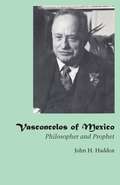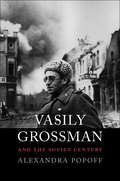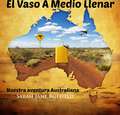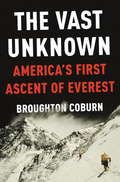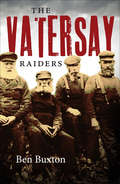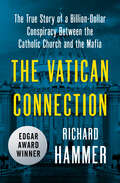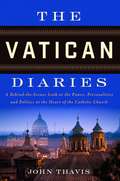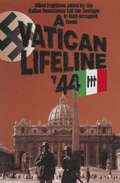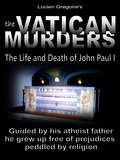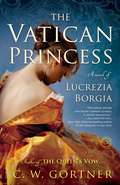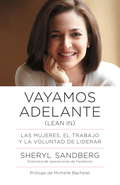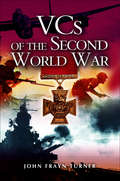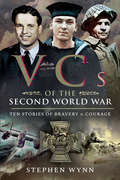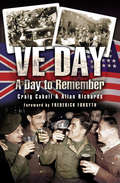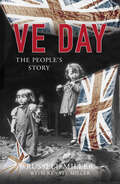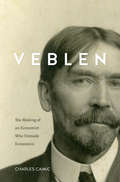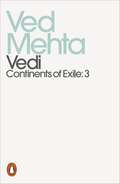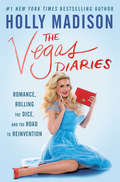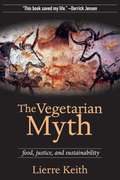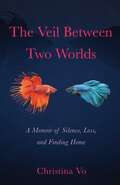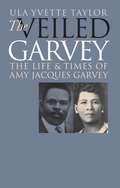- Table View
- List View
Vasconcelos of Mexico: Philosopher and Prophet
by John H. HaddoxJosé Vasconcelos--lawyer, politician, writer, educator, philosopher, prophet, and mystic--was one of the most influential and controversial figures in the intellectual life of twentieth-century Mexico. Vasconcelos was driven by the desire to gain a complete and comprehensive vision of reality, employing his own aesthetic-emotive method and a poetic mode of expression. The complex philosophical system that resulted is what he called "aesthetic monism. " But this is only one side of the man. Vasconcelos was also vitally interested in both the proximate realities and remote possibilities of Mexico, in the character of the "cosmic race" of his homeland, and in the relations between his own country and the others of this hemisphere. Soon after Vasconcelos's death in 1959, Eduardo García Máynez spoke of him, in a moving tribute, as "without question the most inspiring intellectual and human figure that Mexico has produced. " Unhappily--and perhaps disgracefully--he has remained almost unknown outside the Spanish-speaking world. Histories of Mexico published in English usually give passing mention to his role as Minister of Public Education or his unsuccessful campaign for the presidency, but his aesthetic system and his socio-political ideas have been ignored by philosophers in the United States. Here, for the first time, is a unified, inclusive, and occasionally critical presentation of the entire range of Vasconcelos's thought, from his metaphysics and theory of knowledge through his aesthetics and ethics to his social and political philosophy. It is enriched by an appendix in which the most significant passages from Vasconcelos's own philosophical writings are presented in English translations. José Vasconcelos - lawyer, politician, writer, educator, philosopher, prophet, and mystic - was one of the most influential and controversial figures in the intellectual life of twentieth-century Mexico. Vasconcelos was driven by the desire to gain a complete and comprehensive vision of reality, employing his own aesthetic-emotive method and a poetic mode of expression. The complex philosophical system that resulted is what he called "aesthetic monism". But this is only one side of the man. Vasconcelos was also vitally interested in both the proximate realities and remote possibilities of Mexico, in the character of the "cosmic race" of his homeland, and in the relations between his own country and the others of this hemisphere. Soon after Vasconcelos's death in 1959, Eduardo García Máynez spoke of him, in a moving tribute, as "without question the most inspiring intellectual and human figure that Mexico has produced". Unhappily - and perhaps disgracefully - he has remained almost unknown outside the Spanish-speaking world. Histories of Mexico published in English usually give passing mention to his role as Minister of Public Education or his unsuccessful campaign for the presidency, but his aesthetic system and his socio-political ideas have been ignored by philosophers in the United States. Here, for the first time, is a unified, inclusive, and occasionally critical presentation of the entire range of Vasconcelos's thought, from his metaphysics and theory of knowledge through his aesthetics and ethics to his social and political philosophy. It is enriched by an appendix in which the most significant passages from Vasconcelos's own philosophical writings are presented in English translations.
La vasija que Juan fabricó
by Nancy Andrews-GoebelIn Spanish. This vibrant storyis sure to enlighten all who are fascinated by traditional art forms, Mexican culture, and the power of the human spirit to find inspiration from the past.Juan Quezada is the premier potter in Mexico. With local materials and the primitive methods of the Casas Grandes people - including using human hair to make brushes and cow manure to feed the flames that fire his pots - Juan creates stunning pots in the traditional style. Each is a work of art unlike any other. The text is written in the form of "The House That Jack Built" and accompanied by a comprehensive afterword with photos and information about Juan's technique as well as a history of Mata Ortiz, the northern Mexican village where Juan began and continues to work. This celebratory story tells how Juan's pioneering work has transformed Mata Ortiz from an impoverished village into a prosperous community of world-renowned artists. Translated from The Pot That Juan Built, La vasija que Juan fabricó is sure to enlighten all who are fascinated by traditional art forms, Mexican culture, and the power of the human spirit to find inspiration from the past.
Vasily Grossman and the Soviet Century
by Alexandra PopoffThe definitive biography of Soviet Jewish dissident writer Vasily Grossman If Vasily Grossman’s 1961 masterpiece, Life and Fate, had been published during his lifetime, it would have reached the world together with Pasternak’s Doctor Zhivago and before Solzhenitsyn’s Gulag. But Life and Fate was seized by the KGB. When it emerged posthumously, decades later, it was recognized as the War and Peace of the twentieth century. Always at the epicenter of events, Grossman (1905–1964) was among the first to describe the Holocaust and the Ukrainian famine. His 1944 article “The Hell of Treblinka” became evidence at Nuremberg. Grossman’s powerful anti‑totalitarian works liken the Nazis’ crimes against humanity with those of Stalin. His compassionate prose has the everlasting quality of great art. Because Grossman’s major works appeared after much delay we are only now able to examine them properly. Alexandra Popoff’s authoritative biography illuminates Grossman’s life and legacy.
El Vaso A Medio Llenar: Nuestra aventura Australiana
by Rosa Feijoo Andrade Sarah Jane ButfieldCuando una familia del Reino Unido con padrastros e hijastros toma la difícil decisión de buscar una nueva vida en Australia, parece que todos sus problemas terminarán a medida que comiencen esa nueva vida. La existencia en Australia excede sus expectativas hasta que eventos desafiantes que incluyen penas, pérdidas y problemas de relación ponen a prueba su positividad, persistencia y determinación. Sin embargo, una prueba mayor está por venir cuando pierden su casa y todas sus pertenencias ante las inundaciones de Brisbane en enero de 2011. Entonces tiene que decidir ¡hasta donde ya es suficiente! Un emocionante historia verdadera con la cual los lectores podrán identificarse.
The Vast Unknown
by Broughton CoburnBy the author of the New York Times bestselling Everest: Mountain Without Mercy, this chronicle of the iconic first American expedition to Mt. Everest in May 1963 - published to coincide with the climb's 50th anniversary - combines riveting adventure, a perceptive analysis of its dark and terrifying historical context, and revelations about a secret mission that followed. In the midst of the Cold War, against the backdrop of the Bay of Pigs fiasco, the space race with the Soviet Union, and the quagmire of the Vietnam War, a band of iconoclastic, independent-minded American mountaineers set off for Mt. Everest, aiming to restore America's confidence and optimism. Their objective is to reach the summit while conducting scientific research, but which route will they take? Might the Chinese, in a public relations coup, have reached the top ahead of them? And what about another American team, led by the grandson of a President, that nearly bagged the peak in a bootleg attempt a year earlier? The Vast Unknown is, on one level, a harrowing, character-driven account of the climb itself and its legendary team of alternately inspiring, troubled, and tragic climbers who suffered injuries, a near mutiny, and death on the mountain. It is also an examination of the profound sway the expedition had over the American consciousness and sense of identity during a time when the country was floundering. And it is an investigation of the expedition's little-known outcome: the selection of a team to plant a CIA surveillance device on the Himalayan peak of Nanda Devi, to spy into China where Defense Intelligence learned that nuclear missile testing was underway.From the Hardcover edition.
Vatchal: वाटचाल
by Nana Kunteही वाटचाल आहे माझ्या सार्वजनिक जीवनाचा मी स्वतः काढलेला आलेख. दर्यासारंग आंग्रे घराण्याची राजधानी, कुलाबा (रायगड) जिल्ह्याचे प्रमुख ठिकाण अशा मोठ्या बिरुदांनी आमचे अलिबाग बाह्य जगाला परिचित असले तरी प्रत्यक्षात आजही त्याची लोकसंख्या दहा हजारांपलीकडे फारशी गेलेली नाही. अशा गावात माझे मॅट्रिकपर्यंतचे आयुष्य गेले. रत्नागिरी जिल्ह्यातून सुमारे तीनशे वर्षांपूर्वी अलिबागजवळच्या नागाव या अष्टागरातील एका प्रमुख गावी आल्यापासून फक्त शेती-बागायती करणाऱ्या, पोटापुरते मिळविणाऱ्या शेतकरी कुटुंबातील नव्याने वकील झालेल्याचा मी मुलगा. एकत्र कुटुंब, प्रमुख व्यवसाय शेती-बागायत. अष्टागरातील शेतकरी कोणत्याही जातीचा असो, आपल्या शेतात, वाडीत स्वतः राबणारा आणि त्यात धन्यता मानणारा. आपले प्रौढ जीवन सार्वजनिक कामात घालवावे असे मला लहानपणापासून वाटत आलेले आहे. शिवाजीच्या मावळ्यांप्रमाणे स्वराज्याकरिता झटण्याचे आकर्षण. इतिहासात शिवाजीने आणि माझ्या बालपणी स्वातंत्र्यवीर सावरकरांनी घालून दिलेला धडा गिरवावा अशी स्वप्ने मी पाहात असे. प्रभू रामापेक्षा हनुमान किंवा शिवाजीपेक्षा तानाजीच मला जास्त आवडे. नाथमाधवांचा ‘सावळ्या तांडेल’ पुस्तकरूपाने आणि शिवरामपंत परांजप्यांची ‘गोविंदाची गोष्ट’ चित्रमयजगत् या मासिकात वाचलेली.
The Vatersay Raiders
by Ben BuxtonA Scottish historian recounts how Hebridean croft farmers raided a neighboring island in order to survive—and sparked a national debate over land rights. In 1906, men from the Hebridean islands of Barra and Mingulay took possession of the uninhabited island of Vatersay. Two years later, they were imprisoned for refusing to leave—and for building huts and planting potatoes without permission. The case caused an outcry across Scotland, and the government eventually bought Vatersay for the purpose of croft farming. In the first book on the subject, historian Ben Buxton tell the full story of the Vatersay Raiders: their struggle to escape the oppressive policies of an absentee landowner, the raiding and settlement of the island, and the fraught process of dividing it up into crofts. The book also documents the larger history of Vatersay, from intriguing monuments of prehistory to shipwrecks and the 19th century evictions that left it uninhabited. An outline of subsequent developments, including the Vatersay Causeway which connects the island to Barra, completes the narrative.
The Vatican Connection: The True Story of a Billion-Dollar Conspiracy Between the Catholic Church and the Mafia
by Richard HammerWinner of the Edgar Award: The riveting account of an audacious fraud scheme that stretched from a Mafia hangout on the Lower East Side to the Vatican. With a round, open face and a penchant for tall tales, Matteo de Lorenzo resembled everyone&’s kindly uncle. But Uncle Marty, as he was known throughout the Genovese crime family, was one of the New York mob&’s top earners throughout the 1960s and &’70s, the mastermind of a billion-dollar trade in stolen and counterfeit securities. In the spring of 1972, de Lorenzo and his shrewd and ruthless business partner, Vincent Rizzo, traveled to Europe to discuss a plan to launder millions of dollars worth of phony securities. Shockingly, the plot involved Archbishop Paul Marcinkus, the scandal-plagued president of the Vatican Bank. Unbeknownst to de Lorenzo and Rizzo, however, the NYPD was already on the case—thanks to the crusading work of Det. Joseph Coffey. Coffey, the legendary New York policeman who investigated the Lufthansa heist and took the Son of Sam&’s confession, first learned of the scheme in a wiretap related to the attempted mob takeover of the Playboy Club in Manhattan. From those unlikely beginnings, Detective Coffey worked tirelessly to trace the fraudulent stocks and bonds around the world and deep into the corridors of power in Washington, DC, and Rome. Meticulously researched and relentlessly gripping, The Vatican Connection is a true story of corruption and deceit, packed with &“all the ingredients of a thriller&” (San Francisco Chronicle).
The Vatican Diaries: A Behind-the-Scenes Look at the Power, Personalities, and Politics at the Heart of the Catholic Church
by John ThavisThe revealing "New York Times" bestseller examines the reign of Pope Benedict, the papal conclave process, and the history of one of the worlds oldest and most mysterious institutions For more than twenty-five years John Thavis held one of the most fascinating journalistic jobs in the world: reporting on the inner workings of the Vatican. His daily exposure to the power, politics, and personalities in the seat of Roman Catholicism gave him a unique, behind-the-scenes perspective on an institution that is far less monolithic and unified than it first appears. Thavis takes readers from a bell tower high above St. Peters to the depths of the basilica and the saints burial place, from the politicking surrounding the election of a new pope and the ever-growing sexual abuse scandals around the world to controversies about the Vaticans stand on contraception, and more. Perceptive, sharply written, and witty, "The Vatican Diaries" will appeal not only to Catholics (lapsed as well as devout) but to any readers interested in international diplomacy and the role of religion in an increasingly secularized world.
A Vatican Lifeline '44: Allied Fugitives aided by the Italian Resistance foil the Gestapo in Nazi-occupied Rome
by William SimpsonA memoir of an Allied soldier and former POW in Rome, and the unexpected support he received from the Italian people—and from a heroic Catholic monsignor. It is a widely held belief that the Italians in the Second World War failed to win much in the way of martial glory. But the scoffers tend to overlook the fact that most Italians had little or no feeling of animosity toward the Allies—and to wage war against an enemy with whom you have no quarrel is a contradiction in terms. This contradiction is vividly portrayed in William Simpson&’s dramatic account of his time in Rome after the downfall of Mussolini and Italy&’s withdrawal from the war in September 1943, when thousands of Allied prisoners of war, let loose in surrendered Italy, fell prey to occupying Nazi forces. Simpson, an escaped POW, managed, after some hair-raising adventures, to find his way to Rome and soon discovered how widespread was the support of the Italians for the Allies, and how deep-seated their hatred of the Nazis. His adventures during the months before the Allies finally liberated Rome, helping to house and feed hundreds of Allied prisoners on the run, make for compulsive reading—and leave no doubt about the extraordinary bravery of the many Italians who came to their aid. But the real hero of this dramatic story is Monsignor O&’Flaherty, who, with remarkable sangfroid, used the somewhat precarious neutrality of the Vatican, where he was employed, to help Simpson and his fellow fugitives.
The Vatican Murders: The Life and Death of John Paul I
by Lucien Gregoire"A monumental work of twentieth century capitalism as it was jointly embraced by the Vatican and the United States and those caught up in it. Top-shelf CIA-Vatican intrigue." The Times // Some claim the Vatican Bank had to do with his murder. Others claim his threat to change doctrine that unfairly penalizes the lives of innocent people drove curial cardinals in the clandestine deed. Others claim the threat he was to the capitalistic tenets upon which the United States was founded rallied the CIA to action. Others whisper his sexual orientation led to his demise. 'The Vatican Murders' reveals how each of these played a role in the murder of the youngest pope to die in four hundred years. // When elected he was tabbed a liberal on a few bits which had reached outside Italy. Like the times he had been caught baptizing illegitimate children, to the times he had been caught officiating at funerals of the remarried, to the times he ordered hospitals to admit partners of homosexuals into ICUs, to the time he defended their right to parent children, to the times he defied the contraception ban, to the time he declared "God is the Father. More so, the Mother." // On March 13, 1978, fourteen men sat around a table in a village café in northern Italy. In casual clothes they went unnoticed though one was the Pope and another the Marxist leader of the Russian Orthodox Church. Included were Italian cardinals and statesmen who had been behind the rise of the Communist Party in Italy. The others were cardinals of impoverished parts of the world. Together they comprised the leadership of the Marxist movement in the western world. They left at 4 o'clock and Aldo Moro reserved the table "...for this time next year." // On March 13, 1979, cardinals Benelli and Felici decided not to travel to northern Italy that day. After all, all the others were dead. They--unaware of their impending doom--were, too, as good as dead........ True Life - True Crime.
The Vatican Princess
by C. W. GortnerFor fans of Philippa Gregory and Alison Weir, bestselling author C. W. Gortner effortlessly weaves history and drama in this captivating novel about one of the world's most notorious families. Glamorous and predatory, the Borgias fascinated and terrorized fifteenth-century Renaissance Italy, and Lucrezia Borgia, beloved daughter of the pope, was at the center of the dynasty's ambitions. Slandered as a heartless seductress who lured men to their doom, was she in fact the villainess of legend, or was she trapped in a familial web, forced to choose between loyalty and survival? With the ascension of the Spaniard Rodrigo Borgia as Pope Alexander VI, a new era has dawned in Rome. Benefitting from their father's elevation are the new pope's illegitimate children--his rival sons, Cesare and Juan, and beautiful young daughter Lucrezia--each of whom assumes an exalted position in the papal court. Privileged and adored, Lucrezia yearns to escape her childhood and play a part in her family's fortunes. But Rome is seductive and dangerous: Alliances shift at a moment's notice as Italy's ruling dynasties strive to keep rivals at bay. As Lucrezia's father faces challenges from all sides, the threat of a French invasion forces him to marry her off to a powerful adversary. But when she discovers the brutal truth behind her alliance, Lucrezia is plunged into a perilous gambit that will require all her wits, cunning, and guile. Escaping her marriage offers the chance of happiness with a passionate prince of Naples, yet as scandalous accusations of murder and incest build against her, menacing those she loves, Lucrezia must risk everything to overcome the lethal fate imposed upon her by her Borgia blood. Beautifully wrought, rich with fascinating historical detail, The Vatican Princess is the first novel to describe Lucrezia's coming-of-age in her own voice. What results is a dramatic, vivid tale set in an era of savagery and unparalleled splendor, where enemies and allies can be one and the same, and where loyalty to family can ultimately be a curse.Advance praise for The Vatican Princess"A tale of passion, political intrigue, and poisonous power. Assiduously researched and expertly crafted, this novel takes readers inside the treacherous world of the Borgias--one of history's most dysfunctional ruling families--and brings to life the sympathetic and freshly imagined character of their leading lady, Lucrezia. This unholy plunge into Rome's darkest dynasty is wholly engrossing."--Allison Pataki, New York Times bestselling author of Sisi: Empress on Her Own"Elegantly written and deeply researched, with a pacy style and a fine eye for contemporary detail . . . The world of Renaissance Italy is vividly brought to life--I'm captivated by this knowledgeable author's take on the controversial Borgias."--Alison Weir, New York Times bestselling author of Katherine of Aragon, The True Queen "A spiderweb of Renaissance intrigue with a cast of legendary characters, The Vatican Princess tells Lucrezia Borgia's story in her own words. Impressive research, a lush background, and deft characterization of these turbulent times make for a fascinating read."--Margaret George, New York Times bestselling author of Elizabeth I"Here is a marvelously evocative portrait of a young woman caught in a bewildering web of jealousy, family rivalry, vengeance, and papal politics. This is historical fiction at its best, written by a master of the genre."--Patricia Bracewell, author of Shadow on the CrownFrom the Hardcover edition.
Vayamos adelante
by Sheryl SandbergA pesar de que las mujeres alcanzaron hace años niveles de educación similares a los de los hombres, ellos ostentan aún la gran mayoría de puestos directivos, tanto en las empresas como en los gobiernos. Por ello, las voces femeninas todavía no se escuchan por igual en las decisiones que más nos afectan en nuestras vidas.En Vayamos adelante, Sheryl Sandberg examina las razones por las cuales el avance de las mujeres hacia los puestos de responsabilidad está estancado, explica las causas profundas y ofrece soluciones prácticas y aplicables para lograr que las mujeres alcancen su máximo potencial.Sandberg, directora de operaciones de Facebook y una de las mujeres más influyentes del mundo, impartió en 2010 una inolvidable conferencia en TEDTalk, que se convirtió en un fenómeno y que ha sido vista dos millones de veces. En Vayamos adelante, Sandberg profundiza en estos temas combinando anécdotas personales y datos relevantes, y proporciona consejos prácticos para el desarrollo de una carrera profesional satisfactoria, alentando a las mujeres a establecer límites y a abandonar el mito de "haber alcanzado todo".Escrito con humor y sabiduría, el libro de Sandberg es una llamada inspiradora a la acción y un plan de crecimiento individual. Vayamos adelante está destinado a cambiar el planteamiento sobre qué pueden hacer las mujeres y qué no.
VCs of the Second World War
by John Frayn TurnerPublished for the first time in a single volume, VCs of the Second World War consolidates the accounts of the actions of every recipient. The medal of this ultimate honor is inscribed with the simple words For Valour and this cross of courage was awarded to a total of 180 men - many posthumously.As these stories of bravery are unfolded, they reveal varied exploits of incredible individual actions. And they frequently form part of larger-scale operations, whether on land, in the air, at sea or under the sea. In so doing, the book becomes a unique chronological cross-section of the crucial British and Commonwealth contribution to the war as a whole from Norway; the Battle of Britain; North Africa; the Battle of the Atlantic; the Burma campaign; the Mediterranean theater; the air assault on Germany; Normandy; to victory in Europe and the Far East.
VCs of the Second World War: Ten Stories of Bravery & Courage
by Stephen WynnDramatic accounts of ten Victoria Cross recipients and what they did to earn this highest of honors during WWII.During the Second World War, the Victoria Cross—the highest honor to be given to British or Commonwealth forces—was awarded on 182 occasions to 181 recipients, 85 of which were bestowed posthumously.Presented here are ten examples of those who showed the utmost gallantry and bravery “in the presence of the enemy,” with each individual case and the circumstances in which the award was won examined in close detail. One example is the story of Charles Upham, 2nd Division, New Zealand Expedition Force, who was the only recipient of two Victoria Crosses: the first awarded during the Battle of Crete in 1941, and the second during fighting at El Ruweisat Ridge, Egypt, in 1942. Others include Premindra Singh Bhagat of the Indian Army, who rapidly cleared fifteen minefields despite close enemy fire and personal injury, and RAF pilot Leonard Cheshire, who received the honor after his fourth tour of duty. These and other rousing and dramatic stories are true profiles in courage.
VE Day: A Day to Remember
by Craig Cabell Allan RichardsThe authors have compiled a collection of memories and anecdotes from celebrities and members of the public covering their experiences of the Second World War and the day that Victory over the Nazis was declared. We hear from not only those in the Armed Forces but civilians.The book catches the mood of jubilation and exhilaration yet also the great sadness of the huge waste of human life and resources. Hard times still lay ahead.
VE Day: The People's Story
by Russell MillerDrawing from first-hand interviews, diaries and memoirs of those involved in the VE Day celebrations in 1945, VE Day: The People’s Story paints an enthralling picture of a day that marked the end of the war in Europe and the beginning of a new era. VE Day affected millions of people in countless ways, and the voices in this book – from both Britain and abroad, from civilians and service men and women, from the famous and the not-so-famous – provide a valuable social picture of the times. Mixed with humour as well as tragedy, rejoicing as well as sadness, regrets of the past and hopes for the future, VE Day is an inspiring record of one of the great turning points in history.
Veblen (Routledge Studies In The History Of Economics Ser. #115)
by Charles CamicA bold new biography of the thinker who demolished accepted economic theories in order to expose how people of economic and social privilege plunder their wealth from society’s productive men and women.Thorstein Veblen was one of America’s most penetrating analysts of modern capitalist society. But he was not, as is widely assumed, an outsider to the social world he acidly described. Veblen overturns the long-accepted view that Veblen’s ideas, including his insights about conspicuous consumption and the leisure class, derived from his position as a social outsider.In the hinterlands of America’s Midwest, Veblen’s schooling coincided with the late nineteenth-century revolution in higher education that occurred under the patronage of the titans of the new industrial age. The resulting educational opportunities carried Veblen from local Carleton College to centers of scholarship at Johns Hopkins, Yale, Cornell, and the University of Chicago, where he studied with leading philosophers, historians, and economists. Afterward, he joined the nation’s academic elite as a professional economist, producing his seminal books The Theory of the Leisure Class and The Theory of Business Enterprise. Until late in his career, Veblen was, Charles Camic argues, the consummate academic insider, engaged in debates about wealth distribution raging in the field of economics.Veblen demonstrates how Veblen’s education and subsequent involvement in those debates gave rise to his original ideas about the social institutions that enable wealthy Americans—a swarm of economically unproductive “parasites”—to amass vast fortunes on the backs of productive men and women. Today, when great wealth inequalities again command national attention, Camic helps us understand the historical roots and continuing reach of Veblen’s searing analysis of this “sclerosis of the American soul.”
Vedam Venkataraya Sastry
by Vedam Venkataraya SastryLife and works of Vedam Venkataraya Sastry, by his grandson Vedam Venkataraya Sastry (Junior).
Vedi: Continents of Exile: 3 (Penguin Modern Classics)
by Ved MehtaBook 3 in Ved Mehta's Continents of Exile series. Nearly 50 years in the making, Continents of Exile is one of the great works of twentieth-century autobiography: the epic chronicle of an Indian family in the twentieth century. From 1930s India to 1950s Oxford and literary New York in the 1960s-80s, this is the story of the post-colonial twentieth century, as uniquely experienced and vividly recounted by Ved Mehta.Ved continues the story of Ved Mehta's two earlier memoirs, Daddyji, a biographical portrait of his father, and Mamaji, an exploration of his mother and her history. The focus here turns toward Mehta's childhood, his education in an Indian orphanage for the blind, and the general experience of blind people in India.
Veera Shivaji
by Balu SathyaThis book is a biography of Shivaji Bhosle who led a resistance to free the Maratha nation from the Sultanate of Bijapur to establish Hindu Swarajya and founded the Maratha empire in the western part of India. He was reigning during 1642–1680 CE. and was crowned as "Chhatrapati" (means king of the Kshatriyas).
The Vegas Diaries: Romance, Rolling the Dice, and the Road to Reinvention
by Holly MadisonThe #1 New York Times bestselling author returns with this candid, humorous, and captivating memoir chronicling her journey toward reinvention and self-acceptance.When you've come out the other side of the bizarre, twisted world of the Playboy mansion, where do you land? If you're Holly Madison . . . there's no place like Las Vegas!After making the sudden decision to reclaim her life, Holly broke free from the sheltered, deceptive confines of the mansion (which meant exiting a hit television show) and was determined to start her life over . . . from scratch. Without the security of a job or relationship, she set out to reinvent herself on no one's terms but her own.Deciding to roll the dice and begin again in the glamorous and dreamlike city of Las Vegas, Holly quickly realized that while she may have left her past in the rearview mirror, the labels and stereotypes that came from it weren't so quick to leave her. With a fierce commitment to take charge of her own narrative, Holly dives headfirst into a journey of self-discovery. After a whirlwind stint on Dancing with the Stars, she snags the coveted lead role in the Strip's hottest new burlesque spectacular and lands a reality series spotlighting her new life as a single woman. If her own television show and dream job as a showgirl weren't enough to keep her busy, Holly explores the decadent, exclusive inner-world of Sin City, navigating it's social and dating scene with humor and heart. When it comes to romance, she is met with an eclectic cast of characters, from fame hounds to long distance loves to the occasional celebrity and more than one tabloid mishap. In this reflective, heartwarming memoir, Holly learns that each dating disaster holds an important, and in some cases difficult to face, lesson about herself.The Vegas Diaries is a comedy of errors, set against the glitz and glamour of the dazzling Vegas strip. Through the wild and crazy experiences on one young woman's quest to "have it all," Holly faces her fears, anxieties, and insecurities to discover that her journey to self-sufficiency is also her path to healing. Letting go of trying to prove herself to others, Holly finally gains the courage to confront her past-and in the process finds the life and love she deserves.
The Vegetarian Myth: Food, Justice, and Sustainability
by Lierre KeithPart memoir, nutritional primer, and political manifesto, this controversial examination exposes the destructive history of agriculture--causing the devastation of prairies and forests, driving countless species extinct, altering the climate, and destroying the topsoil--and asserts that, in order to save the planet, food must come from within living communities. In order for this to happen, the argument champions eating locally and sustainably and encourages those with the resources to grow their own food. Further examining the question of what to eat from the perspective of both human and environmental health, the account goes beyond health choices and discusses potential moral issues from eating--or not eating--animals. Through the deeply personal narrative of someone who practiced veganism for 20 years, this unique exploration also discusses alternatives to industrial farming, reveals the risks of a vegan diet, and explains why animals belong on ecologically sound farms.
The Veil Between Two Worlds: A Memoir of Silence, Loss, and Finding Home
by Christina VoChristina Vo has always struggled with the concept of &“home.&” The daughter of an emotionally distant father and a mother who died when she was just fourteen, she continues to grapple with that legacy of loss and her constant quest to, as a fortysomething, find a reconciliation with the shape her life has taken. In January 2021, feeling a call to be closer to the land, she decides to leave San Francisco—this time permanently, she hopes—and set off on a road trip with one of her closest friends, David.Christina and David begin their journey with an ayahuasca ceremony in Santa Barbara, then continue on to Ojai and ultimately Santa Fe—two magical lands that serve as deep portals for healing. Throughout their travels, Christina reflects on the recent and distant past: her relationships, her past experiences in Santa Barbara and Ojai (where she stayed for nine months around her fortieth birthday, two years ago) and her evolving understanding of her relationship with her parents. All the while, she ponders how the past has shaped her current identity as a single, childless, and motherless woman in her forties. Within the context of intimate friendship, she discovers how thin the veil between worlds can be, and gradually comes to realize that her mother&’s spirit has accompanied her since day one of her journey.Deeply reflective and ultimately joyful, Vo&’s memoir takes us on a journey between two worlds—the physical and the spiritual—that eventually brings her to a newfound understanding of how to deepen connections with others, as well as to a place of peace and home within herself.
The Veiled Garvey
by Ula Yvette TaylorIn this biography, Ula Taylor explores the life and ideas of one of the most important, if largely unsung, Pan-African freedom fighters of the twentieth century: Amy Jacques Garvey (1895-1973). Born in Jamaica, Amy Jacques moved in 1917 to Harlem, where she became involved in the Universal Negro Improvement Association (UNIA), the largest Pan-African organization of its time. She served as the private secretary of UNIA leader Marcus Garvey; in 1922, they married. Soon after, she began to give speeches and to publish editorials urging black women to participate in the Pan-African movement and addressing issues that affected people of African descent across the globe. After her husband's death in 1940, Jacques Garvey emerged as a gifted organizer for the Pan-African cause. Although she faced considerable male chauvinism, she persisted in creating a distinctive feminist voice within the movement. In her final decades, Jacques Garvey constructed a thriving network of Pan-African contacts, including Nnamdi Azikiwe, Kwame Nkrumah, George Padmore, and W. E. B. Du Bois. Taylor examines the many roles Jacques Garvey played throughout her life, as feminist, black nationalist, journalist, daughter, mother, and wife. Tracing her political and intellectual evolution, the book illuminates the leadership and enduring influence of this remarkable activist.
